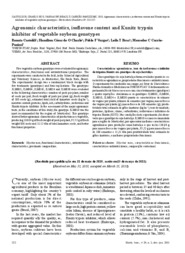Agronomic characteristics, isoflavone content and Kunitz trypsin inhibitorof vegetable soybean genotypes.
Agronomic characteristics, isoflavone content and Kunitz trypsin inhibitorof vegetable soybean genotypes.
Author(s): CASTOLDI, R.; CHARLO, H. C. de O.; VARGAS, P. F.; BRAZ, L. T.; CARRÃO-PANIZZI, M. C.
Summary: Five vegetable soybean genotypes were evaluated for agronomic characteristics, functional and antinutritional properties. The experiments were conducted in the field, in the School of Agricultural and Veterinary Sciences, in Jaboticabal, São Paulo State, Brazil. The experimental design was a randomized block design with five treatments (genotypes) and four replications. The genotypes JLM003, JLM004, JLM010, JLM024 and JLM030 were evaluated in the following caharacteristics: number of pods per plant, number of seeds per pod, fresh weight of pods per plant (g), fresh weight of 100 seeds (g), estimated total yield of immature seeds (kg ha-1), moisture content, proteins, lipids, ash, carbohydrates, isoflavones and Kunitz trypsin inhibitor. In the assessment of the major agronomic traits, in the conditions of this study, the genotype JLM010 was the most recommended for the region of Jaboticabal. This genotype showed better agronomic characteristics of production as a vegetable, producing 136.04 g of fresh weight of pods per plant, 92.52 g of fresh weight/100 seeds and 11.12 t/ha of total immature seeds, and better functional properties. Características agronômicas, teor de isoflavonas e inibidor de tripsina Kunitz em genótipos de soja-hortaliça: Cinco genótipos de soja-hortaliça foram avaliados quanto às características agronômicas, propriedades funcionais e antinutricionais. O experimento foi conduzido em campo, no Setor de Olericultura e Plantas Aromático-Medicinais na UNESP-FCAV. O delineamento experimental foi de blocos ao acaso com cinco tratamentos (genótipos) e quatro repetições. Avaliaram-se os genótipos JLM003, JLM004, JLM010, JLM024 e JLM030 quanto às características de número de vagens por planta; número de sementes por vagem; massa fresca das vagens por planta (g); massa fresca de 100 sementes (g); produtividade total estimada de grãos imaturos (kg ha-1); teor de umidade; proteínas; lipídeos; cinzas; carboidratos; isoflavonas e inibidores de tripsina Kunitz (KSTI). Nas condições deste experimento, foi observado que o genótipo de soja-hortaliça JLM010 é o mais recomendado para a região de Jaboticabal, por apresentar melhores características agronômicas para produção como hortaliça o que inclui 136,04 g para massa fresca das vagens por planta, 92,52 g para massa fresca de 100 sementes e 11,21 t/ha para produtividade total estimada de grãos imaturos, e melhores propriedades funcionais.
Publication year: 2011
Types of publication: Journal article
Unit: Embrapa Soybean
Observation
Some of Embrapa's publications are published as ePub files. To read them, use or download one of the following free software options to your computer or mobile device. Android: Google Play Books; IOS: iBooks; Windows and Linux: Calibre.
Access other publications
Access the Agricultural Research Database (BDPA) to consult Embrapa's full library collection and records.
Visit Embrapa Bookstore to purchase books and other publications sold by Embrapa.

